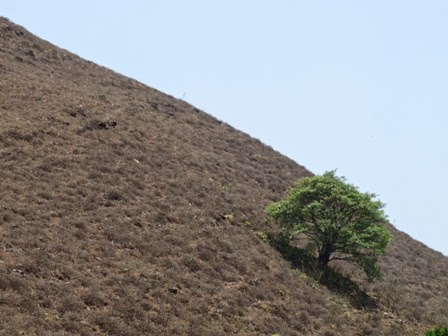It had been a few months since we went on a trek. Seeing the natural beauty of Madikeri and its surroundings, we were rearing to go on a nice long walk. There were a few operators who take you on fixed trekking routes and they were charging Rs.4000 for a couple, for a day's trek. We were clear that we did not want to walk through a forest on a cloudy / rainy day. You know leeches etc. and so, we had look at other options if any.
When we heard about Mandalpatti and the views along the way, we decided to trek there. Mandalpatti is about 24 kms. from Madikeri's bus depot. Large part of the route is motorable road. But the last 5 - 6 kms. is bad, and some places no roads, where you have to go on hired jeeps. The jeep ride costs Rs.1500 and a very short wait, we were told. As we wanted to do the trek in a leisurely manner and enjoy the journey as much a s the destination, we took an auto rickshaw (for Rs.1000 for half a day) till the point where they are allowed, and from there started on our 5 (?) km. trek.
To be on the safe side, we carried lunch and plenty of water. Good pair of walking shoes and a hat, donot forget walking sticks finished our preparations, and we set off at a leisurely pace taking in the scenic beauty along the route.
As far as your eye can see, you will only see mountain ranges; rows and rows of mountains. The altitude is upwards of 1500m. In the valleys, where mountains meet, you can see abundance of trees. It looks as if green water is flowing through the joints, from a distance. Very picturesque!
The road, which is more like a trail, winding through the mountains, some covered with vegetation, some others totally bald, is easy, gently climbing.
There were trails made by jeep tires on several mountains by adventurous souls! Into the distance we could see very high mountains. The light was hazy for clear pictures.
This brown and brown black butterfly seems to be a common variety there. it was a delight to see them fluttering about everywhere.
These wild flowers gave it an arid and desert feel to the region though lovely to look at.
On the side of a mountains you could see a lone tree trying to hang on to its roots. How it survived when none did, surprises me.
As we kept walking and climbing, the number of butterflies increased. They seemed to be from the same family, ie. family of blue and brown butterflies. I came across this small bush, by the side of the road, on which there must have been 25 to 30 butterflies of the same colour.
It was an amazing sight.
Best thing about trekking is (as compared to going by the jeep) you can stop whenever you catch sight of a breathtaking view. And there were numerous such views. the road goes winding on and on. In the above photograph, if you concentrate, you will notice an arch way at the end of the path. We thought the view point must be close behind it.
Once you reach the archway you can see the view point. It was at least 2 kms. from the archway. At the foot of the hill, there is a sort of an office, and a few police personnel were there. Th reach the viewpoint we had to climb a short hill. There is a pavilion at the summit and spiral staircase leading to the roof.
We rested our feet inside the pavilion for some time and unpacked our lunch and did justice to the sandwiches and soft drinks. From the top you get a 360 degrees view of the western ghats. You will only see mountains and row upon row, and finally they merge into the sky.
They said the views during rainy season and past the monsoons are spectacular. The march light created its own special effects.
The air was fresh and pure, the sky hazy, the views serene and no habitation any where close, you can contemplate, be part of the scenery, marvel at the majesty of the mountains, and if you love nature in all its varied manifestations, then do not miss Mandalpatti view point if you are in the vicinity of Coorg.













%2BGold%2BEstate%2B-%2BMadikeri.JPG)

















